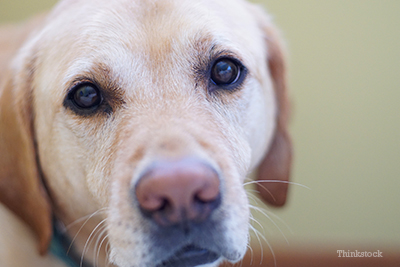Zee Mahmood, a veterinary technician in Reading, PA, contributed to this article.
When we hear the words "enlarged prostate" we might think of men with difficulty going to the bathroom because of old age or even cancer. Male dogs are also subject to prostate disease (also known as prostatomegaly). An enlarged prostate can affect middle-aged to senior, male dogs of any size or breed.
What’s the prostate? The prostate is a gland that normally lives inside the pelvis, behind the bladder and below the rectum. Normally, the prostate reaches its maximum size by the time a dog is two years old.
The prostate is a gland that normally lives inside the pelvis, behind the bladder and below the rectum. Normally, the prostate reaches its maximum size by the time a dog is two years old.
Do all dogs have a prostate gland?
When a dog is neutered before puberty, the prostate gland does not develop due to the lack of testosterone (the male hormone produced by the testicles). This is no problem for dogs since the prostate's main job is to support and carry sperm cells. Also, when a mature dog is neutered, the prostate will actually shrink. This means that a neutered male dog's risk for prostate disease is greatly decreased, even after puberty.
What are the signs of prostate disease?
In a man, difficult or painful urination is a telltale sign of a diseased prostate, since the swollen prostate will decrease the size of the urethra. In a dog, however, the enlarged prostate will usually push up on the rectum, causing painful or difficult defecation. Stool may be ribbon-shaped. This is a classic sign of an enlarged prostate.
Dogs will also often walk abnormally, as if they are "walking on eggshells." Dog guardians may observe pets straining to urinate, or a discharge of blood or pus from the penis. It is important to remember, however, that dogs with prostate disease may show no signs whatsoever.
The 4 main prostate diseases
There are 4 main conditions of the prostate to be aware of:
1. Benign Prostatic Hyperplasia
The most common form of prostate disease is known as Benign Prostatic Hyperplasia, or BPH. It is caused by normal aging of the prostate. As a dog ages, the prostate can become larger. This enlargement causes pressure on the surrounding structures. BPH typically causes some degree of prostate enlargement in almost all dogs over 5 years of age. This can cause mild discomfort as well as difficulty defecating and/or urinating.
2. Cysts
Cysts are a typically filled with fluid, similar to a blister. They can develop within the prostate tissue itself or around the surface of the gland. They will slowly increase in size.
3. Infection
The prostate may become infected by bacteria. Such infections can be difficult to treat with medications only. A long-standing infection may create pockets of pus, called abscesses, within the gland.
4. Cancer
Unlike in men, prostate cancer is not common in male dogs. When it does happen, this cancer can metastasize (or spread) to other organs such as the liver or lymph nodes. It can also affect the bones of the pelvis or the spine. While prostate cancer is rare in dogs, it is important to remember that it is potentially life-threatening.
Diagnosing prostate disease
During the exam, your veterinarian will insert a gloved finger into your dog's rectum and feel the prostate, noting its size and shape. Your vet can also assess whether or not the prostate is painful. A urine sample can be tested for evidence of infection or prostate disease. X-rays can also be used to assess the size of the prostate and the surrounding structures in order to evaluate changes in size or appearance. Ultrasound is a great option to determine the nature of the disease affecting the prostate in a quick and non-invasive manner. It can also help to take a biopsy of the prostate to test for cancer.
Treating prostate disease
Treating prostate disease depends on the underlying cause. For instance:
- A bacterial infection of the prostate can require 6-8 weeks of antibiotics
- If an abscess or large cysts develop, it must be drained during surgery
- Radiation or chemotherapy may be an option for prostatic cancer
If applicable, treatment also involves neutering in almost all cases. When the testicles are removed, the source of testosterone is removed as well. The prostate then shrinks, as it would have if the dog had been neutered during puppyhood. “While neutering doesn’t completely guard against prostate cancer, it does prevent enlargement and possible infection of the prostate,” says ASPCA.
[See the top 10 reasons to neuter your pet.]
Questions to ask your veterinarian if your dog has prostate disease:
- What is the best way to determine the nature of the disease?
- What is the best treatment?
- What is the likely outcome for my dog?
If you have any questions or concerns, you should always visit or call your veterinarian -- they are your best resource to ensure the health and well-being of your pets.
